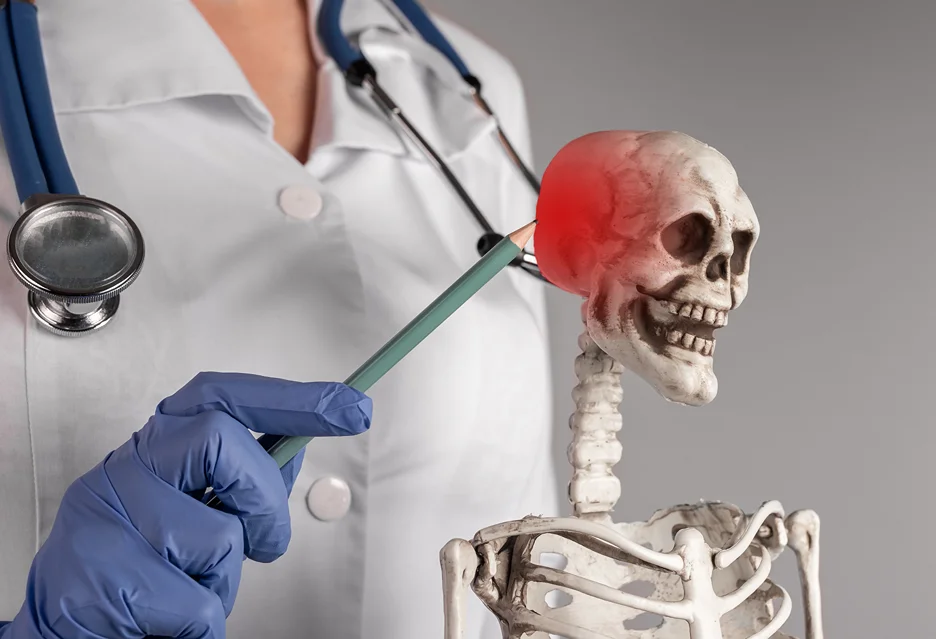Severe neck pain that radiates up into the base of the skull is no joke. The persistent, throbbing headache makes it agonizing to get through your day. Painkillers provide little headache relief.
Just turning your head sends lightning bolts shooting down your neck. Sleep becomes elusive as you desperately seek out a comfortable position that eases the pounding between your head and shoulders.
If you’re suffering from severe headaches accompanied by neck pain at the base of your skull, you’re not alone. This frustrating medical condition affects countless people worldwide. The good news is that with proper diagnosis and treatment, relief is possible.
Common Causes of Headaches and Neck Pain at the Base of the Skull

Before finding relief, it helps to understand what’s causing the pain in the first place. Here are some of the most common culprits behind headaches accompanied by neck pain at the base of the skull:
Cervicogenic Headaches
Cervicogenic means “severe pain generated from the neck.” Nerves that exit the cervical spine can become irritated, inflamed, or compressed, resulting in referral pain that travels up the back of the head. Issues like disc herniations, arthritis, muscle strain, and prior neck injuries are often to blame.
Occipital Neuralgia
The occipital nerves run from the top of the cervical spine through the scalp at the base of the skull. Damage or compression of these nerves can cause burning, shooting pain in the occiput or back of the head.
Tension Headaches
Chronic muscle tightness and trigger points in the neck and shoulders from poor posture, emotional stress, or overuse can refer to pain in the base of the skull and cause debilitating tension headaches.
Migraines
While migraines often cause one-sided, pulsating head pain, some migraine sufferers also experience pain in the neck at the base of the skull. Migraine headaches have a variety of triggers like hormones, foods, and weather changes.
Arthritis
Degenerative changes and bone spurs in the cervical facet joints and discs from osteoarthritis or old injuries can impinge nerves and cause severe headaches and neck pain.
As you can see, there are many possible causes. An accurate diagnosis is key to finding the appropriate treatment. Next, let’s look at the most common symptoms.
Typical Symptoms of Headaches and Neck Pain at the Base of the Skull
No two headaches or necks feel exactly the same. But some themes emerge among those suffering from pain and headaches at the base of the skull:
- Pain ranging from mild to excruciating at the base of the skull, top of the neck, and back of the head
- Constant, throbbing aches or intense, stabbing pains
- Pain that worsens with neck movement or turning the head
- Reduced neck mobility and stiffness
- Soreness and tenderness of neck muscles
- Associated dizziness, light sensitivity, nausea, and fatigue
- Sensitivity to light, blurred vision
Of course, every case is unique. Additional symptoms depend on the underlying condition. Keeping a headache journal to identify triggers and describe your exact symptoms helps your doctor make an accurate diagnosis.
Diagnosing the Cause of Headaches
Getting to the root cause of your severe neck pain and headaches is crucial for finding the right treatment. Here are some of the ways healthcare professionals diagnose headaches:
- Medical history – Discussing your symptoms, family history, headache triggers, and prior injuries helps identify patterns.
- Physical exam – Testing neck mobility, nerve function, muscle tone, and areas of tenderness.
- Imaging Tests – MRIs, CT scans, and X-rays reveal bone spurs, disc, issues, arthritis, and anatomical anomalies.
- Trigger point injections – Injections that temporarily numb trigger points in neck muscles can determine if they are causing headaches.
- Nerve blocks – Anaesthetic injections in branches of the occipital nerves identify if they are the pain source.
- Blood tests – Blood work checks for potential infection, inflammatory markers, and nutritional deficiencies.
Getting the right diagnosis is key. Many find it helpful to see both their family doctor and a neurologist or headache specialist when dealing with severe and chronic headaches.
Seeking Effective Relief: Treatment Options for Headaches
Once properly diagnosed, there are many routes to finding relief from headache and neck pain at the base of your skull:
Medications
Depending on the cause and pain intensity, medications that may help include:
- Over-the-counter pain relievers like acetaminophen, ibuprofen, and naproxen sodium
- Prescription medications like muscle relaxers and migraine abortive and preventative medications
- Corticosteroid injections and nerve blocks
- Antidepressants and anticonvulsants for pain modulation
- Botox injections to relax neck muscles
However, many prefer to explore conservative approaches first before trying prescription medications or injections.
Physical Therapy
Stretching tight neck muscles, improving range of motion, and strengthening the neck and upper back can help reduce headaches. Physical therapists also use targeted soft tissue massage, joint mobilization, traction, and therapeutic ultrasound to treat neck pain and cervicogenic headaches.
Massage Therapy
Massage techniques like trigger point therapy, neuromuscular therapy, and myofascial release loosen tight neck muscles and restore alignment of the cervical spine to alleviate headaches at the base of the skull.
Chiropractic Adjustments
Acupuncture
Acupuncture stimulates trigger points and restores proper energy flow to ease muscle and nerve pain causing headaches at the base of the skull.
Lifestyle Changes
Improve posture, establish regular sleep routines, reduce stress, exercise moderately, and avoid headache triggers. This limits muscle tension and prevents your condition from worsening.
Ergonomic Optimization
Set up your workstation properly to avoid neck strain from computers. Limit neck craning staring at phones. Use cervical pillows and maintain neutral postures to combat tension and headaches.
A combination approach often works best. Your doctor or healthcare professional can help design a treatment regimen targeting the mechanics behind your headaches and neck pain.
Consistency is key – it can take time to retrain muscles and treat sources of nerve irritation. But most find sustained relief possible when they stick to a therapeutic plan.
Take Control of Your Pain

If you’re suffering from debilitating headaches accompanied by neck pain at the base of your skull, you don’t have to tough it out. Following the steps outlined in this guide will help you find answers and a path forward.
Getting an accurate diagnosis from your doctor is the critical first step. Once the cause is identified, there are many conservative treatment approaches to try before considering prescription medications or injections.
Be your own health advocate. Keep track of symptoms, discuss all therapy options with your providers, and stay focused on targeted treatments to address the root issue. Relief from the severe headaches plaguing you is within reach.
If you’re experiencing discomfort in your neck, let us assist you on the path to relief. At Kaly, our team of dedicated health professionals is here to understand your specific needs and provide tailored solutions to alleviate your neck pain. Trust in our expertise and let us help guide you toward a pain-free life. We’re here for you every step of the way.
